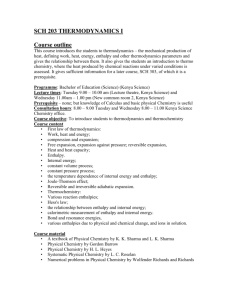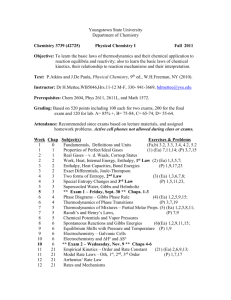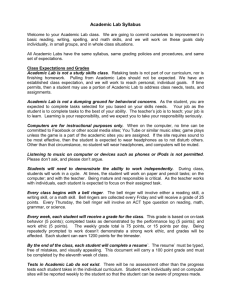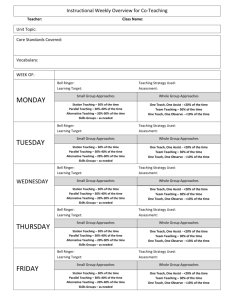3 - Thermochemistry & Thermodynamics
advertisement
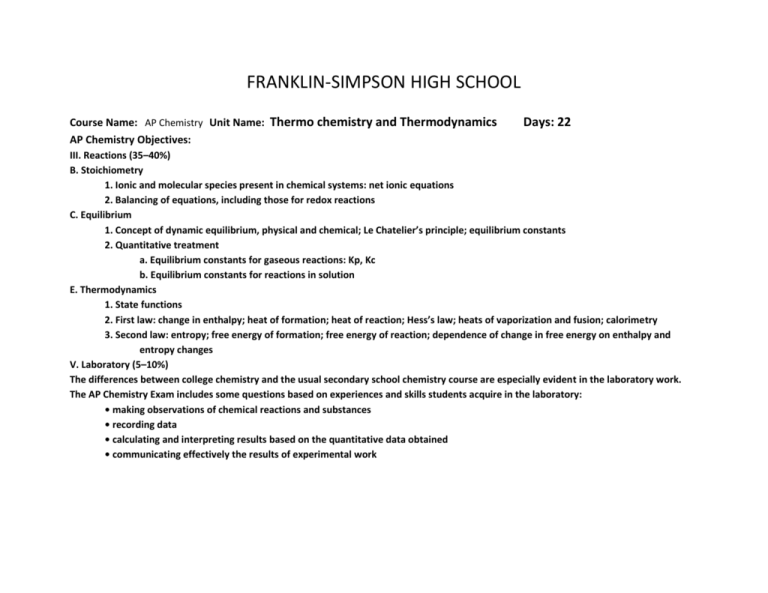
FRANKLIN-SIMPSON HIGH SCHOOL Course Name: AP Chemistry Unit Name: Thermo chemistry and Thermodynamics AP Chemistry Objectives: Days: 22 III. Reactions (35–40%) B. Stoichiometry 1. Ionic and molecular species present in chemical systems: net ionic equations 2. Balancing of equations, including those for redox reactions C. Equilibrium 1. Concept of dynamic equilibrium, physical and chemical; Le Chatelier’s principle; equilibrium constants 2. Quantitative treatment a. Equilibrium constants for gaseous reactions: Kp, Kc b. Equilibrium constants for reactions in solution E. Thermodynamics 1. State functions 2. First law: change in enthalpy; heat of formation; heat of reaction; Hess’s law; heats of vaporization and fusion; calorimetry 3. Second law: entropy; free energy of formation; free energy of reaction; dependence of change in free energy on enthalpy and entropy changes V. Laboratory (5–10%) The differences between college chemistry and the usual secondary school chemistry course are especially evident in the laboratory work. The AP Chemistry Exam includes some questions based on experiences and skills students acquire in the laboratory: • making observations of chemical reactions and substances • recording data • calculating and interpreting results based on the quantitative data obtained • communicating effectively the results of experimental work Purpose of the Unit: Thermochemistry comes early in a typical college text. That chapter deals primarily with calorimetry and enthalpy. AP students say it makes more sense to them to include entropy and free energy immediately after thermochemistry. This unit looks at changes in enthalpy and entropy and the relationship between the two to Gibb’s free energy in determining the overall spontaneity of a reaction, as well as energy absorbed or released by a reaction and the amount of order/ disorder obtained by a system. Several methods, both experimental and mathematical, will be used in these determinations. Prerequisites: Students will need an understanding of: exothermic and endothermic reactions Lewis structures of compounds and bond energies Equilibrium constants Daily Lesson Guide Day 1-3 Lesson Content and Objectives Thermochemistry: Calorimetry and ΔH III.E.1, 2, 3 Focus Questions What determines if a reaction is endothermic or exothermic? Critical Thinking (High Yield / Literacy /LTF/etc.) * Summarizing and note taking * I Do – We Do – You Do * Analysis/ Application * Learning with others Engagement * ACT bell ringer * Take notes on modeled notes * Solve problems within notes solo and in small groups (formative) Assessment and/or Accommodations * Evaluate student sample problems for understanding 4-6 7-9 Laboratory: AP Chemistry required Laboratory 13: Determination of Enthalpy Change Associated with a Reaction V. Thermochemistry: Enthalpy, Hess’s Law, Bond Energy III.B.1, 2 III.E.1, 2, 3 1012 Thermodynamics: Entropy, ΔS III.B.1, 2 III.E.1, 2, 3 1315 Thermodynamics: Free Energy, ΔG III.B.1, 2 III.C.1, 2 III.E.1, 2, 3 How can the amount of energy absorbed/ released by a reaction be measured experimentally? * Learning with Others * Generating and testing Hypotheses * Authenticity * Novelty and Variety * Analysis/ Applications/ Synthesis How can the amount of energy absorbed/ released by a reaction be calculated? What effect does adding energy to a system have on the reaction? How does disorder (entropy) drive a reaction? Can it be calculated? * Summarizing and note taking * I Do – We Do – You Do * Analysis/ Application * Learning with others How can the amount of energy available to do work determine spontaneity of a reaction? Are there exceptions? * Summarizing and note taking * I Do – We Do – You Do * Analysis/ Application * Learning with others * Summarizing and note taking * I Do – We Do – You Do * Analysis/ Application * Learning with others * ACT bell ringer * Work in small lab groups to solve a lab problem * Use data collected to calculate enthalpy change (summative) * ACT bell ringer * Take notes on modeled notes * Solve problems within notes solo and in small groups (formative) * Evaluate lab reports * Students can check themselves by verifying their results among other lab groups * ACT bell ringer * Take notes on modeled notes * Solve problems within notes solo and in small groups (formative) * ACT bell ringer * Take notes on modeled notes * Solve problems within notes solo and in small groups (formative) * Evaluate student sample problems for understanding * Evaluate student sample problems for understanding * Evaluate student sample problems for understanding 1620 AP Thermodynamics & Thermochemistry FRQ’s and MCQ’s III.B.1, 2 III.C.1, 2 III.E.1, 2, 3 V. How will I be tested over thermochemistry & thermodynamics on the AP Chemistry Exam? How does everything I just learned fit together with what I already know? * Learning with others * Choice * Clickers 2122 Unit Exam III.B.1, 2 III.C.1, 2 III.E.1, 2, 3 V. * Can I use my knowledge to take an AP-like exam covering thermochemistry and thermodynamics? * Evaluation * Analysis * Application * Synthesis * Authenticity * ACT bell ringer * Work independently, then in small groups, then as whole class to solve and grade FRQ’s with AP rubrics * Use clickers and Turning Point to answers MC Questions from retired AP exams (summative) * ACT bell ringer * Solve retired AP Chemistry MC and FR Questions * Graded by AP standards and rubrics (summative) * Evaluate student responses and provide immediate feedback on FRQ’s and MC’s with rubrics and keys * Evaluate exam
